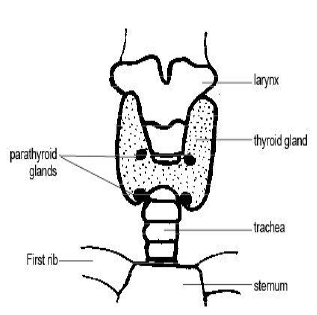
In most mammals the thyroid gland is located caudal to the trachea. The gland is composed of two lobes connected by a narrow piece of tissue called the isthmus. The thyroid tissue is composed of thousands of follicles that consist if spheres formed by simple cuboidal epithelium whose lumen contains a gelatinous homogeneous staining substance called colloid. Colloid is the main storage form of thyroid hormones.
Located in between the follicles are blood vessels, connective tissue and parafollicular (C) cells. The C cells secrete the hormone calcitonin which is important in the regulation of calcium. 2 molecules are required for thyroid hormone synthesis:
Tyrosine and iodine (iodide). Tyrosine is a part of a large molecule called thyroglobulin (glycoprotein) that composes the colloid in the follicles.
The colloid is formed within the follicular cells before being secreted into the lumen. Iodide is obtained from diet and is highly concentrated within the follicular cells.
When 2 iodide molecules combine with tyrosine, we get di-iodotyrosine (T2).
The coupling of 2 di-iodotyrosines result in the formation of tetra-iodotyrosine (T4).
The coupling of one mono-iodotyrosine and one di-iodotyrosine molecules results in tri-iodotyrosine (T3). T3 and T4 are the main thyroid hormones.
After synthesis, the thyroid hormones remain in lumen till they are released.
marto answered the question on
April 16, 2019 at 08:35